This should be a great day. NOAA said sunny, light wind, high in the 50s.
It's February in Northeast Florida. At 4:30 AM it is dark out. The day won't begin
until 6:30 with the first rays of sunlight peeping over the horizon.
This is the perfect time of day when you're spirits are lifted and the sun comes out
to charge your batteries.
Ted and Kent will be at the ramp. We are guides scouting some new areas along the Matanzas River,
about 60 miles north of where I live.
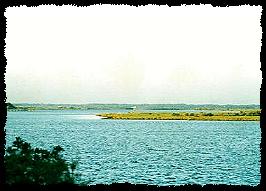
Matanzas, Pellicer Creek and the Marineland Flats are interesting places. This area is
separated from the Atlantic by a narrow piece of land with Matanzas Inlet feeding the inshore
flats. It is pretty wild and pretty beautiful. There is every kind of mangrove plant from black to
white and small plants with purple flowers.
Palmettos grow close to the water's edge, birds and raccoons eat the berries, which are
used for jams and jellies. Very few people fish the flats because it is difficult to access;
most people think the only place you can catch inshore game fish is Mosquito Lagoon.
All these areas along the Atlantic Coast up to the Carolinas have equally great fishing.
The 10-mile run north from Bing's, up and past Rattlesnake Island, and the island that
is home to the now abandoned Fort Matanzas, is great. There is just the hint of a breeze,
the trees are motionless, sea grass moves in the direction of the incoming tide. We will
try to locate a school of redfish, or jacks if possible.
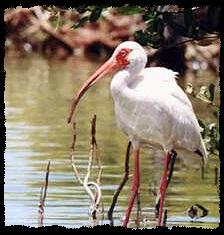 Rounding marker 82 (M82), we can see the outflow of the Matanzas River from the Inlet
at Summer Haven. Large predator fish come in this narrow channel under a fixed bridge
from the Atlantic. From M82 to M79, near Cedar Landing, there is a lot of activity,
especially on an incoming tide. Just south of SR206 is the flats and bend at Devil's Elbow.
Fast moving current and only 100-feet separates the Intercoastal Waterway (ICW) from the ocean. As we cut to
the west, flats that run south of where SR 206 runs from I-95 to Crescent Beach, we spot
a disturbance on the water's surface. Getting much closer we shut down just out of distance
so we don't spook the fish. This area holds a lot of game fish including reds, black drum, trout,
snook, jacks and flounder.
Rounding marker 82 (M82), we can see the outflow of the Matanzas River from the Inlet
at Summer Haven. Large predator fish come in this narrow channel under a fixed bridge
from the Atlantic. From M82 to M79, near Cedar Landing, there is a lot of activity,
especially on an incoming tide. Just south of SR206 is the flats and bend at Devil's Elbow.
Fast moving current and only 100-feet separates the Intercoastal Waterway (ICW) from the ocean. As we cut to
the west, flats that run south of where SR 206 runs from I-95 to Crescent Beach, we spot
a disturbance on the water's surface. Getting much closer we shut down just out of distance
so we don't spook the fish. This area holds a lot of game fish including reds, black drum, trout,
snook, jacks and flounder.
It is one of the best kept secrets in Florida, just south of the oldest city in America St. Augustine.
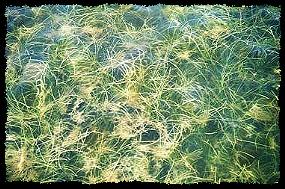
A mullet jumps like he's shot from a cannon, then another, something could be chasing them.
We study the water, but we don't see any game fish. In shallow water big game fish will cut
a 'V' through the water, like a submarine just below the surface, this is called a push. The
water is pushed out rather than down making a kind of wake just back of the dorsal fin.
A blow out (large fish pushing fast from a mud hole) is also a giveaway. Surface commotion
and showering bait means predatory fish are schooling together to gorge themselves.
Nervous water, tickling water, boiling water are other indicators of baitfish. You won't
waste any time by being patient and really taking a good look around. Sometimes binoculars
are useful for checking signs of baitfish, feeding birds, crabs, and anything else that will be
attractive to feeding fish. Scanning the grass line at water's edge can really payoff. You
could easily spot a tailing red or a push on the flat water next to a grass line. The water in
February is gin clear and you can see deep into the water column.
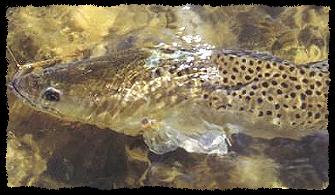 Along this edge of the flat the water is about four feet deep. A trolling motor works really
well and keeps us moving slowly. Ten feet out from a small canal running northwest, Keith
gets a bump on a hair bug. Each of us will use a different fly. The first catch will determine
which one is more effective. The hair bug pushes water and has an action similar to a lure.
Keith works the fly so that it moves side-to-side and darts ahead. Out from the reeds we
can see a large push moving towards the fly. There is no hook up but the trout is about 8
or 10 pounds - a monster. Its beautiful spots stand out against the white hole and grass.
Along this edge of the flat the water is about four feet deep. A trolling motor works really
well and keeps us moving slowly. Ten feet out from a small canal running northwest, Keith
gets a bump on a hair bug. Each of us will use a different fly. The first catch will determine
which one is more effective. The hair bug pushes water and has an action similar to a lure.
Keith works the fly so that it moves side-to-side and darts ahead. Out from the reeds we
can see a large push moving towards the fly. There is no hook up but the trout is about 8
or 10 pounds - a monster. Its beautiful spots stand out against the white hole and grass.
This is good feeding area for trout that love feeding baitfish near the surface. They
usually come blasting out of their hiding places in the tall grass. Even in four feet of
water the grass rises about 18 inches above the surface. Any movement is detected
by the grass moving and swaying above the waterline as a big fish maneuvers below.
Heavily concealed, the trout makes his run to the fly and slams it. He pushes the hair bug
right out of the water and makes a run shaking his head side-to-side to dislodge the hook.
Ted has the first fish of the day, our day is 'on'.
Ted gets a hook up on a small trout. The first couple of hours prove fairly productive.
Five trout have been caught and released. Both a white/chartreuse half/half and an ultra
hair bug have worked. I'm using a Kelly Spoon Fly in green/salmon specks. We decide
to move to another area on the flats just west of the Green Street boat ramp.
There are many oyster outcroppings and we hook up more trout. Moving south along this flat,
I get a bump on the spoon fly, but not hookup. I recast to about the same position and get
another bump. This goes on for a while. My line it bumped again but I can't get a hook up.
There are two bumps and my line gets tight, my rod almost folds in half. The slack line is
now on the reel and line peeling out. We haven't seen what has this spoon fly, but what ever
has it is big. The fish makes a run to an oyster bar and dives. He's under the boat. I step
from gunnel to gunnel, stern to bow. The line is very tight, then it goes slack, he's coming up,
I start reeling. Down we go again.
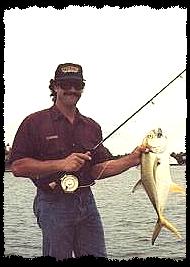
After about an hour of this, I figure this has to be a Jack Cravelle in the 10 to 20 pound range.
The next time he tries coming up, I'm going to risk breaking the leader by using his
momentum to pull him out of the water. As he starts his next run up, I pull straight up,
planeing him to the surface while winding at the same time. Almost clearing the water
is a giant redfish over 40 inches long and about 30 pounds or more. He is all a deep
copper color and absolutely beautiful. We have both had enough of this tug of war
and as I get him close to the side, he is cut loose. This puts much less stress on the fish.
The two dollar fly will dissolve in about 3-hours.
The wind has picked up and it is time we head back. Out on the ICW we just round a
bend on Devil's Elbow and Jose points to a bar on the west bank, "JACKS." Yes,
there is the classic motion in the water of jacks breaking up baitfish, they are ravenous
like piranhas eating a dead animal. They move the baitfish so they become airborne
just above the water's surface. The ribbon of aching pilchards
are moving at break-neck speed.
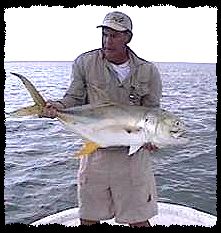 Kent gets a red hair bug into the school and immediately hooks up, he's in for an awesome
time. The jack weighs in at 18 pounds. Now, I'm on a jack, fighting with all the fury
of a killer whale, shaking, running and spitting. This one is 15 pounds. Ted gets a
26-pounder. They are everywhere. When a boat passes us on the ICW, they disappear.
This is normal. Down they go, wait 5 minutes and they will resurface.
Kent gets a red hair bug into the school and immediately hooks up, he's in for an awesome
time. The jack weighs in at 18 pounds. Now, I'm on a jack, fighting with all the fury
of a killer whale, shaking, running and spitting. This one is 15 pounds. Ted gets a
26-pounder. They are everywhere. When a boat passes us on the ICW, they disappear.
This is normal. Down they go, wait 5 minutes and they will resurface.
Jacks will take a fly and make an explosive run, usually to the bottom, run out about
50 yards and reverse direction. They will take line into the shallowest water and over
an oyster bed. You'll see them go sideways flapping through the water to shake a
hook. They give the most dramatic display of any fighting fish. There is nothing that
comes close to the excitement of a hooked jack. The pull on a fly rod is so strong,
the tip will bend all the way to the butt until you think the rod will break. They
are very powerful for their size. In ninety minutes we caught 20
jacks, probably some of the same ones twice.
If I could go fishing and only catch jacks I would not be disappointed. The hair bugs
work well but so do Deceivers or Clousers in all white or white and red or yellow. Use
barbless hooks, then releasing them is easy and less stressful on the fish.
Go out and find some Jacks. Take a 9 wt rod, floating or sinking line with 20# bite tippet.
You will have the time of your life. Any size Jack is a thrill on a fly, if you hook a brute
so much the better.
Until next time ~ Doug
About Doug:
Capt. Doug Sinclair has relocated from New Smyrna Beach, Florida to
Grantsboro, NC. He specializes in fly-fishing and light tackle charters.
Doug charters the Coastal Carolina area of New Bern or Oriental.
Catch him on the web at
www.flyfishacademy.net or call him at (252) 745-3500.
Doug is also a Sponsor here on FAOL.
|

